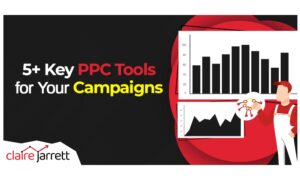Google Ads News for April 2025

Last Updated on: 18th April 2025, 05:46 pm
Hello again, and welcome to another month of Google Ads updates!
In April, we’ve got Google nudging advertisers further into automation, as well as API changes giving Demand Gen campaigns more bite. Oh…and if you thought you were done hearing about PMax, think again.
Let’s jump right in!
Google’s Personalised Growth Plans: Helpful or Herd Mentality?
You might’ve seen this land in your inbox already: a new email from Google Ads with the subject line: “Personalised action plan for growth.”
These emails promise a three-month growth roadmap with weekly tasks, a progress tracker, and a few nods toward “ad strength” improvements.
(Translation: do more of what Google wants you to do.)
They’re claiming that moving from Poor to Excellent ad strength boosts conversions by 12% on average. Still, there’s no breakdown on where that statistic comes from.
What’s inside these plans?
You guessed it…more automation:
- Turning on personalised recommendations (i.e. letting Google make changes for you – something I say you should never do on auto-pilot)
- Adding broad match keywords (i.e. watch your spend creep up with targeting that’s not solely focused on your ideal customers)
- Launching PMax (AKA the campaign type where you get the least control)
Instead of personalisation, I’d call it “standardised automation wrapped in a neat progress bar.”
Now, does that mean you should ignore it entirely?
Not necessarily.
If you know what you’re doing, some of the suggestions may be worth testing – on your terms, in a controlled setup. But these plans are designed to move everyone toward the same setup: broader targeting, more automation, less differentiation.
If enough advertisers follow the same playbook, it becomes harder to stand out and even harder to explain why your results plateau when your competitors’ campaigns look exactly like yours.
As always, read these recommendations with your strategist hat on, not your wishful-thinking one.
They’re a prompt for discussion, not a prescription for action.
Performance Max Gets Smarter in This Month’s Google Ads News (But Don’t Let It Outsmart You)
The latest Google Ads news also features new lifecycle-focused tools inside PMax, and I have to say: some of this is genuinely useful if you know what to do with it.
You can now set retention goals inside PMax.
You can bid differently for lapsed customers – say, the ones who bought six months ago and haven’t returned. We’re getting some control over targeting based on customer stage, beyond just intent signals scraped from browsing behaviour.
Also worth noting: in campaigns set to “new customer only” or “new customer value” mode, you’ll now see a dedicated Customer Acquisition Cost column in your reports.
Of course, this being Google, they’ve bundled in a few more “creative automation” updates too:
- Landing page images will now be pulled in automatically to use as ad creative
- Smart cropping will generate alternate versions of your existing images
In theory, this is about boosting inventory access and ad variety. In reality, it’s one more place you’ll want to double-check what Google’s doing with your brand visuals, especially if you’re working with carefully curated creatives.
Is this the beginning of more serious lifecycle marketing inside PMax? Maybe. But don’t assume that just because you can bid on lapsed customers, your campaign is now magically retention-focused. You still need to segment properly, align your messaging, and watch what these new tools do to your results.
In the right hands, these features could tighten up customer targeting and help squeeze more ROI from existing audiences. In the wrong hands? Well… let’s just say I’d like to see less cropping and more critical thinking.
Oh Look, It’s PMax Google Ads News Again! (This Time, With Statistics)
A new study from Smarter Ecommerce just arrived, and it’s brimming with data on how PMax has evolved over the past three years.
Spoiler: it’s still the centre of Google’s eCommerce strategy, even if some advertisers are quietly stepping back.
According to the study, PMax accounted for nearly 82% of eCommerce ad spend at its peak (back in May 2024). That’s massive.
Since then, that number’s been dropping ever so slightly – about 0.65% a month – but it’s still the dominant format in the room.
The report also notes that 90% of PMax spend typically goes toward feed-based ads.
Here’s where it gets interesting: the average account runs 3-7 PMax campaigns, but over-segmenting is hurting performance.
So, while I understand you if you’ve grown accustomed to being in granular control, building 12 nearly identical campaigns might be hurting your results.
The data also confirms what many of us have already seen in practice: Maximise Conversion Value is beating out Maximise Conversions as the stronger bidding strategy. And it makes sense since Google’s machine thrives on clear value signals, not shallow volume metrics.
Now, some are asking: is PMax on its way out?
Google’s Ginny Marvin has weighed in, saying Standard Shopping isn’t being deprioritised (yet), and products in both campaigns will compete on Ad Rank without “bid escalation.”
PMax isn’t going anywhere, but it’s also not the default solution for every business, and certainly not every campaign.
Google has improved it, no doubt. You can now add more exclusions, apply better signals, and even access reporting that didn’t exist a year ago. But improved doesn’t mean perfect, and it definitely doesn’t mean hands-off.
More API Adjustments from Google, Demand Gen and Video Get the Spotlight
If you’re knee-deep in the technical side of campaign management, Google Ads API v19.1 might be worth a look. There are genuinely useful upgrades here, especially if you’re running Demand Gen or video-heavy accounts.
The big win is ad group-level channel controls for Demand Gen campaigns. This means more granularity and no more hoping that Google’s smart distribution aligns with your strategy.
There’s also a timid update buried in the PMax section: you can now override brand exclusions specifically for Shopping ads inside a PMax campaign.
If you’ve ever had PMax block brand placements you wanted, this gives you a workaround. Just make sure you test it carefully before giving Google full rein again.
For video campaigns, there are new reach and demographic measurement tools, plus support for pulling in audio ad metrics. Great if you’re running broader awareness campaigns and want clearer reporting.
Local Services Ads also got a quiet improvement: you can now submit lead quality feedback directly. Whether Google listens is another question, but it’s a start.
And good news if you’re already on API v19: no major code rewrites needed. Just update your client libraries.
This isn’t a blockbuster update, but it’s a solid batch of quality-of-life changes, particularly for advertisers asking for more control (read: most of us). Google’s still not handing over the keys, but they are at least cracking the window open.
You can check out Google’s official release notes here.
What Do This Month’s Google Ads News Tell Us?
For one, Google’s still walking the line between “we’re giving you more control” and “just trust the machine.”
We’re seeing new features that look great on paper (lifecycle goals, asset testing, more Demand Gen levers), but the pattern remains: the more Google automates, the more you need to understand what’s going on.
If there’s one thing I’d like you to take from today’s roundup, that thing is critical thinking. Your job as a strategist is to decide what genuinely serves your goals/your clients’ goals, not what’s easiest to switch on.
And if you’re struggling to keep up, you’re not alone. Some of my smartest clients know the platform inside out but don’t have time to monitor every feature drop. That’s what my team and I are here for!
And by the way, your foundational knowledge of Google Ads still drives results no matter how fast the platform evolves. So grab a copy of my book, Rapid Google Ads Success. It’s built on 17+ years of experience, and it’ll remind you what works, what matters, and what to ignore entirely.
See you next month. And until then, strategy before settings!









